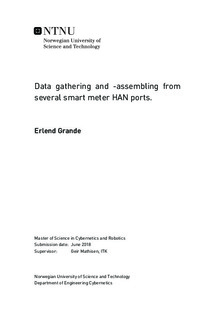Data gathering and -assembling from several smart meter HAN ports.
Master thesis
Permanent lenke
http://hdl.handle.net/11250/2562328Utgivelsesdato
2018Metadata
Vis full innførselSamlinger
Sammendrag
Advanced electronic measuring devices, targeted at measuring power consumption, is replacing the older electro-mechanical metering devices. These devices, abbreviated AMS devices, are considered a significant infrastructure advancement from the conventional measuring of power, as the device is capable of communicating the readings directly to the distribution network manager for monitoring and billing in real time. Although automated power readout and data transfer to a centralized manager is a considerable improvement to the distribution network infrastructure, further advancement is necessary to allow distributed power generation to be incorporated into the radial low-voltage segment of the distribution network and to extend real-time monitoring abilities outside the current boundaries of the distribution network. These properties can enhance measurement quality and reduce measuring errors, allow for real-time regulation of transmission line loads and improve quality to the overall distribution network. A system was designed and implemented, utilizing the Meter-Bus protocol on the Home Area Network (HAN)-port on Kaifa Advanced Metering System (AMS) meters. The system module was designed to log and transmit AMS data read-out through the use of an integrated wireless transmitter and provide cloud-supported availability to the consumer and the distribution network manager. To achieve the notion of multiple devices communicating in real-time, an AMS simulator was necessary to provide data to the modules. This M-Bus simulator was successfully capable of acting as a functional AMS device and therefore allowing aggregated data availability from a decentralized Amazon Web Service (AWS) cloud client.
